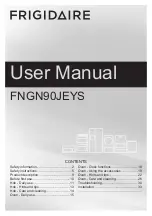
24
49-2001056 Rev. 0
CARE AND CLEANING:
Glass
Cooktop
/
Probe
Damage from Sugary Spills and Melted Plastic
Special care should be taken when removing hot substances
to avoid permanent damage of the glass surface
.
Sugary spillovers (such as jellies, fudge, candy, syrups) or melted plastics can cause pitting of the surface of your
cooktop (not covered by the warranty) unless the spill is removed while still hot. Special care should be taken when
removing hot substances.
Be sure to use a new, sharp razor scraper.
Do not use a dull or nicked blade.
1. Turn off all surface units. Remove hot pans.
2. Wearing an oven mitt:
a. Use a single-edge razor blade scraper to move
the spill to a cool area on the cooktop.
b. Remove the spill with paper towels.
3. Any remaining spillover should be left until the surface
of the cooktop has cooled.
4. Don’t use the surface units again until all of the
residue has been completely removed.
NOTE:
If pitting or indentation in the glass surface has
already occurred, the cooktop glass will have to be
replaced. In this case, service will be necessary.
Glass Cooktop (Cont.)
Probe
The temperature probe may be cleaned with soap and
water or a soap-filled scouring pad. Cool the temperature
probe before cleaning. Scour stubborn spots with a
soap-filled scouring pad, rinse and dry.
To order additional temperature probes, see the
Accessories and Consumer Support sections at the end
of this manual.
■
Do not immerse the temperature probe in water.
■
Do not store the temperature probe in the oven.
■
Do not leave the temperature probe inside the oven
during a self or steam clean cycle.
Metal Marks and Scratches
1. Be careful not to slide pots and pans across your
cooktop. It will leave metal markings on the cooktop
surface.
These marks are removable using the ceramic
cooktop cleaner with a non-scratch cleaning pad for
ceramic cooktops.
2. If pots with a thin overlay of aluminum or copper
are allowed to boil dry, the overlay may leave black
discoloration on the cooktop.
This should be removed immediately before heating
again or the discoloration may be permanent.
NOTE:
Carefully check the bottom of pans for roughness
that would scratch the cooktop.
3. Be careful not to place aluminum baking sheets or
aluminum frozen entrée containers on a hot cooktop
surface. It will leave shinny dots or markings on the
cooktop surface. These markings are permanent and
cannot be cleaned off.
Heavy, Burned-On Residue
1. Allow the cooktop to cool.
2. Use a single-edge razor blade scraper at approximately
a 45° angle against the glass surface and scrape the
soil. It will be necessary to apply pressure to the razor
scraper in order to remove the residue.
3. After scraping with the razor scraper, spread a few drops
of ceramic cooktop cleaner on the entire burned residue
area. Use a non-scratch cleaning pad to remove any
remaining residue.
4. For additional protection, after all residue has been
removed, polish the entire surface with ceramic
cooktop cleaner and a paper towel.
The ceramic cooktop scraper and all recommended supplies
are available through our Parts Center. See the Accessories
and Consumer Support sections at the end of this manual.
NOTE:
Do not use a dull or nicked blade.
Содержание CES700M
Страница 32: ...32 49 2001056 Rev 0 Notes ...
Страница 33: ...49 2001056 Rev 0 33 Notes ...













































